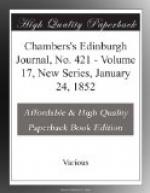4th, Capitalists of L.1000 and upwards can make, apart from wool-growing, twenty per cent. on their money without being in trade, chiefly by buying at the government land-sales, and subdividing the section into small allotments, or by building houses, shops, &c. The average of rental returns the capital in four years. But this can only be done if emigration continues—and emigration with a sprinkling of holders of L.50 to L.200. If this stops, there can be few purchasers. Should a fixed price be put upon government land, there might be a difference in the way in which capital could be turned to profit; but L.1000 and upwards can find so many favourable investments in a new colony, that a living could be secured without much trouble or anxiety.
5th, Population.—By the census just completed, there are 78,000 inhabitants in Victoria (Port-Philip); County of Bourke, 44,000—including Melbourne, the capital, 20,000; County of Grant, 12,000—including Geelong, its capital, 8000. Warnambool, Belfast, and Portland, along the coast, only number hundreds, and Kilmore, forty miles inland, nearly 2000: there are also various villages—on paper—so called, numbering ten to fifty houses each. From this it will be seen that more than half of the entire population is within twenty miles of Melbourne, a third of the residue within fifteen miles of Geelong, and the remainder scattered, including the 1200 squatting-stations, over a very extensive country. These towns are not, in my opinion, a natural growth, but have been forced into their present magnitude from the difficulties in obtaining land at a price to make up for the utter want of every convenience, a want arising from the total absence of any effort on the part of the government hitherto to make even one great trunk-road through the colony. Facilities for internal communication would cause towns to increase naturally. Now, people arrive with glowing ideas of the beauty and fertility of the country, and finding everything difficult of access there, betake themselves to shopkeeping, forcing up rents to an exorbitant sum, and losing their little capital. I think my opinion borne out by the fact, that the country population of Grant County was 1959 in 1846, and 4469 in 1851; Geelong in 1846 had 1911, and in 1851, 8000—the town population more than quadrupling itself in the last five years, the county increasing only 2510. Melbourne and Bourke County are nearly in the same position.
There are seven or eight merchants in Geelong who import goods of all kinds, twenty-two drapery establishments in a respectable way, besides numbers of small ones on the outskirts; other trades are proportionately overdone. Melbourne is, I am credibly informed, equally crowded. These facts shew that there is no opening for people in business. A great imposition is practised by stating the increase of a town at so much per cent., or having doubled or trebled itself in so short a time, the fact being that even its present condition may be that only of a village. Interested parties too often talk their places into notice; and if people do not deal in ‘notions,’ they all have some allotment that will just suit you, which they don’t care to keep any longer.




